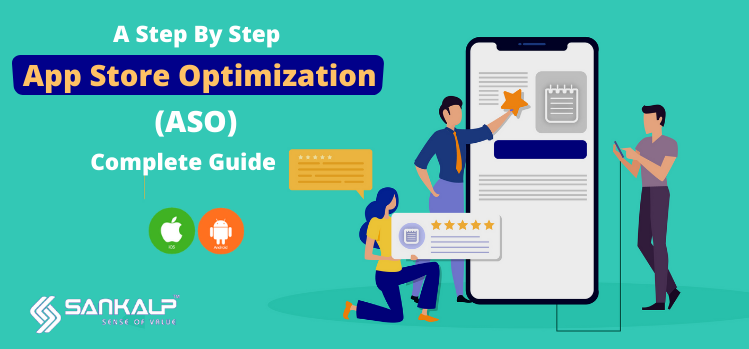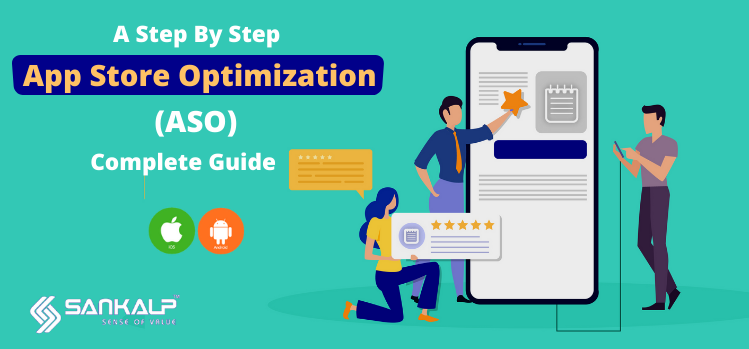Do you know by Q1 2021, how many apps are developed for different platforms?
“A whopping 3.48 million apps on the Android platform and over 2.22 million apps for iOS users!”
With so many apps available, How will you be able to stand out with your app in an ocean of infinite options?
The answer is – App Store Optimization or ASO! This blog offers a Complete Guide to App Store Optimization and how ASO has gained such prominence in recent times.

In this blog, we will learn about “App Store Optimization Complete Guide (ASO) to boost the visibility and ranking of your app.”
- What is App Store Optimization?
- How is it different from Search Engine Optimization?
- How to select the right keywords?
- App Store Optimization Tricks
Ranking on the app store and play store doesn't happen by chance. You need to have a solid ASO strategy in place to influence your growth on the platforms.
What is App Store Optimization?
App store optimization is also known as App store marketing and Mobile App SEO. ASO is all about improving the visibility of the app within Google Play or the Apple app store. With an increase in impressions, the objective is to enhance the traffic to your app for downloads. This process is segregated into 2 parts – optimizing the app page and optimizing the search page. Although the basic goal is to promote app downloads, few other reasons are:
- Positive rating and review of the app
- Engaging target audience with content
- Maximizing brand exposure
How is it different from Search Engine Optimization?
The biggest difference is ASO applies to mobile apps while SEO is done for websites. While the objective of ASO is to push people to download the apps, SEO attracts the audience to click the website. Below is a checklist that demonstrates the key differences and similarities.
ASO
Search Engine – Google Play, Apple App store
ON-PAGE
App name
Description
Keywords
Usage & Quality metrics
Uninstall rates
OFF-PAGE
Ratings and review
Download stats
Backlinks
GOALS
Maximum download of the app
SEO
Search engine – Google search, Yahoo, Bing
ON-PAGE
H1, H2, H3
Title tags
Keyword density
Page speed
Bounce rate
OFF-PAGE
Anchor text
Links
Social signals
GOALS
Maximum visitors on the website
App store search is the most common way of discovering new apps.
Did you know
Over 70% of mobile users utilize search to locate new apps? Furthermore, about 65% of users directly download the app after the search
So, the next big question is how to select the right keywords for app store optimization.
ASO Keystring:
This is designed for the algorithms to pick the keywords and not shown to the front-end users. Once you have the best keywords in your title, name and subtitle, put the remaining keywords in the keystrings. Connect with your development team to update your keystring within your App Store Connect account. As per Apple, avoid using the below keywords:
- Duplicate words
- The word ‘app’
- Name of categories
- Special characters like # or @
- Plural words that are already used in the singular form
App Store Description:
Having a keyword strategy in the description is a key factor. Although descriptions are not directly indexed by algorithms, Apple search ads and Google will index these keywords. You can have the description upto 4k characters, so include the most relevant keywords that reach the users.
Title:
The title of the app is the keyword field that creates the biggest influence on search rankings. Keep the brand name followed by the most appropriate terms that describe the features, USP and component of the app. Thinking from the customer’s perspective can help you in placing the right keywords. Repeating keywords is strictly not advisable as app store algorithms pick up words throughout the metadata.
The best way to list down the keywords is by listing the features of your app. Then compare it with the possible words that users would use to search for the app. In the end, place your keywords in the title, subtitles by mixing the keywords from both lists that are unique and relevant.
Top App Store Optimization tricks
Extensive Research:
Before even finalizing the concept, various factors have to be studied to get the right users. Competitors, user base, language, social proof, keywords, keyword ranking strategy and more. Decide if you want to rank with difficult keywords with higher traffic or top the list for a lesser difficult word.
App Name:
Research suggests that apps that included relevant keywords stand 10.3% higher than apps without proper keywords. Not only branding, but the right app name is also a key part of ASO. Get a catchy name that highlights the USP without getting truncated is the key.
Enhance the app with screenshots & videos:
Though adding screenshots and videos doesn’t help in improving rankings, but certainly helps in driving downloads. Build a story with the first 2-3 screenshots that are displayed to users – it builds up the curiosity.
Localize the app:
Not just translating the language, it’s about adapting as per the country, people and habits. Customize the keywords as per geographical region along with images, videos, the way you highlight the USP’s.
Conclusion
Once the Mobile app development part is over App Store Optimization is more important to get higher visibility and downloads.
If you want to boost the visibility and ranking of your app then ASO is one of the primary ingredients of the recipe for mobile app promotion and success.







Add comment